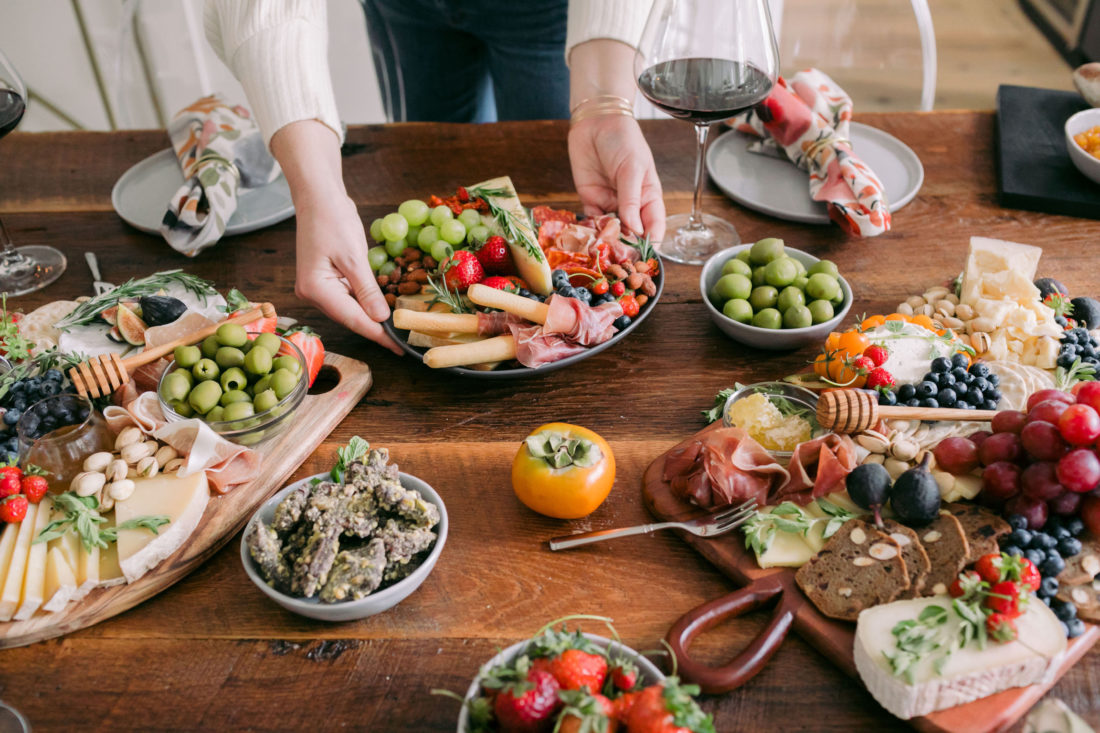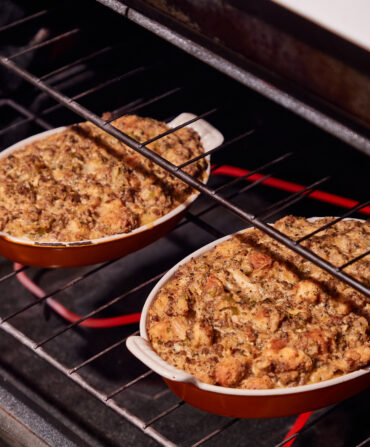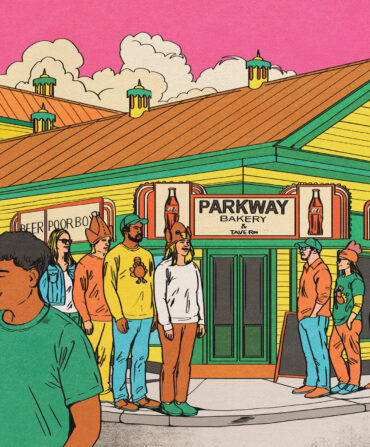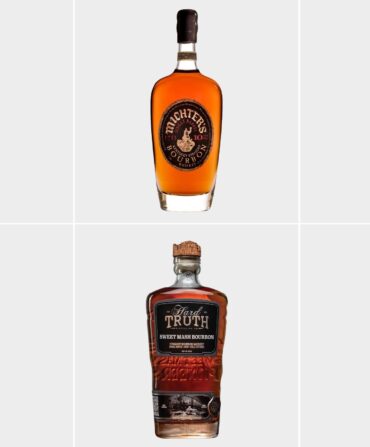
There’s something irresistible about a well-made charcuterie board. A bountiful spread of meats, cheeses, fruits, crackers, nuts, pickles, jams, and other pantry items hits that salty-sweet-fatty trifecta that triggers the pleasure receptors in our brains. When done right, the culinary scene stealer is as visually appealing as it is delicious. Versatile too: Served as an appetizer or the main course, a charcuterie board can be tailored to the season or occasion—something Cortney LaCorte, aka Nashville’s Cheese Gal, knows a thing or two about.
LaCorte’s love of entertaining started early. “I had this obsession with Martha Stewart when I was a little kid. I was literally five years old and pretending to have a fake television show with two teddy bears as my cameramen,” she says. As a teenager, LaCorte encountered her first charcuterie board and was hooked. She spent the next few years feeding friends and family via artfully arranged appetizers and later founded Cheese Gal, building boards for a devoted following of Music City customers. Recently, LaCorte pivoted to full-time content creation, sharing her hard-won charcuterie knowledge with her 100,000-plus followers across social media. A broader entertaining-themed YouTube series is in the works, but until then, she’s breaking down the charcuterie basics for us here.
First things first
Before you go shopping, consider the season or event, and let that inform the look and contents of your board. “The first thing you want to do is think of your color palette because this is really where the board comes to life,” LaCorte says, noting that produce is one of the easiest ways to bring color into your spread. “It’s fall, so we’re at the end of fig season. Grapes are seasonally fresh right now. Apples. Pears too. But I do use berries year-round to fill in any gaps.”
The lowdown on boards
“Honestly, I find myself reaching for a serving platter over a traditional cheese board because typically there is a bit of a lip on serving platters, so you can keep all of the good stuff in a little easier,” LaCorte says. “But I also use a lot of cutting boards. You can build a board on any flat surface.”
If you don’t have something at home or are looking for something new, shop a few of G&G’s favorite Southern-made boards and serving pieces here:
• McQueen Pottery (Maryville, TN): Elegant without being fussy, McQueen’s narrow, oval-shaped Charcuterie Platter features that slight lip LaCorte favors. The handmade platters come in two neutral hues, both dishwasher safe.
• Meadors (Charleston, SC): Dress up your spread with this Large Rectangular Serving Board made from dark polished walnut and edged in bright copper.
• Laurel Mercantile (Laurel, MS): The heirloom-quality Walnut Large Serving Board feeds a crowd and, when you’re not throwing a party, is perfect for chopping veggies.
Choose your cheeses
Once you’ve settled on a look and vessel, LaCorte suggests making your cheese selections early. “I like to choose at least three cheeses,” she says, “and you’ll want to mix up the flavor profile and texture, so choose a hard cheese, semi-hard cheese, and a soft cheese just to give your guests variety.” For soft cheeses, she suggests Brie, Camembert, or a nice goat cheese. Two semi-hard varieties she loves are Manchego and aged Gouda. And for a hard cheese, she always adds an aged cheddar. Pro tip: “Always pre-cut harder cheeses,” LaCorte says. “You want to make the grazing as easy as you can for your guests. Pre-cutting is also visually more inviting.”
Elevate your dairy offerings with the help of these Southern cheesemakers:
• Looking Glass Creamery (Asheville, NC): The South isn’t renowned for its cheddar, but the folks at Looking Glass Creamery are aiming to change that with Drovers Road, an English-style milled cheddar with a rich, earthy flavor and notes of caramel.
• Sequatchie Cove Creamery (Sequatchie, TN): An award-winning farmstead cheese, Dancing Fern is inspired by France’s famous Reblochon cheese, which is similar in texture to Brie, only softer.
• Sweetgrass Dairy (Thomasville, GA): The Thomasville Tomme, a longtime G&G favorite, is a semi-hard cheese made in the style of French farmhouse cheeses and aged for at least sixty days.
Lay out your board
With cheeses selected, LaCorte starts building out the rest of her spread. “If you’re using ramekins or bowls for jams or olives or nuts, you should set them out in this step. You’re essentially building a framework for your board,” she says. After placing those vessels, add any large produce (think bunches of grapes) as well as your cheeses. “I do something called fanning,” LaCorte says. “When you pre-cut your cheese into slices, imagine you’re creating a fan around your bowls. You can do the same with crackers.” And think about symmetry: “If you add crackers to the left, add some to the right,” she says.
As for which spreads to serve, honey is always a good addition, LaCorte says, as are jams and preserves. For fall, she favors fig, apricot, and sour cherry jams. “Also peach jam. I always make a big batch at the end of the season and use it throughout the year.”
With the help of the following mail-order Southern purveyors, there’s no need to slave over a hot stove or even rush out to the grocery store:
• The Peach Truck (Nashville, TN): You can’t go wrong with the Peach Truck’s tangy Signature Peach Jam, but spring for their Peach Jam Trio, which also includes the company’s Bourbon and Jalapeño varieties. All three jams are made with fresh Georgia peaches, but the Jalapeño really rocks a cheese board.
• Georgia Jams (Griffin, GA): Georgia Jam’s low-sugar offerings are designed to let Southern-grown produce shine. Exhibit A: the Bourbon Fig jam, where a splash of Kentucky’s finest gives Georgia figs a grown-up boost without detracting from their all-natural seasonal appeal.
• Blackberry Patch (Thomasville, GA): This tart Cherry Pepper jam was designed with cheese boards in mind and pairs particularly well with the Thomasville Tomme from Sweet Grass Dairy, Blackberry Patch’s neighbor.
Mix in your meat
If you’re serving your board as an appetizer, LaCorte says, “you can get away with just one to two meats,” but if your spread is meant as a light supper, choose at least three cured options—perhaps a hard salami, a thinly sliced foldable salami, and a prosciutto.
While Europeans have been perfecting the art of charcuterie for centuries, they’ve got nothing on these talented Southern makers:
• Curate at Home (Asheville, NC): Celebrated Asheville chef Katie Button brings a taste of Spain to your table with this excellent dry-cured chorizo made with local Carolina pork.
• Spotted Trotter x Porter Road (Atlanta, GA/Nashville, TN): A tasty partnership between Atlanta’s Spotted Trotter and Nashville’s Porter Road, this Salumi Sampler let’s you try all four of the duo’s thinly sliced salami offerings, including a Black Pepper Sorghum salami and a peppery Calabrian version.
• Lady Edison (Chapel Hill, NC): A partnership with the folks at North Carolina’s Goodnight Brothers smokehouse, Lady Edison’s Fancy Country Ham is not quite as salty as a traditional country ham or Italian-made prosciutto. The secret to its melt-in-your-mouth appeal is the mix of heritage pork from Berkshire, Chester White, and Duroc hogs.
Supplement with nuts and other light bites
With your meats, cheeses, crackers, jams, and other spreads placed symmetrically across the board, it’s time to fill in the gaps. “To get that elaborate layered look, you don’t want any empty space on the board,” LaCorte says, which means it’s time to bring in your smaller seasonal items. This is where the initial color palette you chose comes into play. Eliminate any remaining holes and add texture with a mix of nuts and dried fruits. If you’re adding something super salty or tangy like olives or pickles, be a little more intentional with your placement, pairing them with other salty offerings lest flavors rub off a little.
Two Southern makers to consider:
• Hubs Peanuts (Sedley, VA): Completely addictive, the Home Cooked Salted Peanuts are made with extra-large Virginia peanuts and blister-fried, yielding an extra crunchy texture.
• Schermer Pecans (Thomasville, GA): Founded more than seventy-five years ago, Schermer is one of the few family-run Georgia operations that not only grows their own nuts but shells and distributes them too. Opt for one of the farm’s pecan bundles, and you’ll get a bag of their natural shelled nuts and a dressed-up version like cinnamon glazed or chocolate covered.








